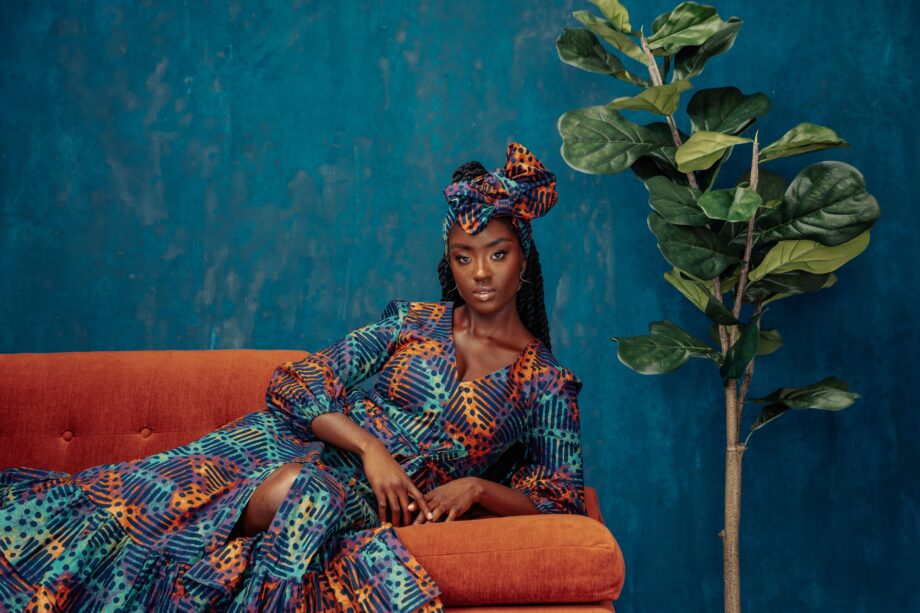African Dress History and Future with D’IYANU
African print dresses and modern African fashion for men, women, and children have become increasingly popular in recent years and have captivated fashion enthusiasts around the globe. The rich heritage and cultural significance behind these garments have played a crucial role in their enduring appeal.
In this article, we will delve into the history of the traditional African fashion and fabrics, explore the influence of trade and colonization, discuss their contemporary presence, and explore the future of African fashion.
African fashion boasts a diverse range of traditional fabric and attire, each with its own unique characteristics. If you enjoy bold printed fashion, traditional dashikis, or vivid colors, you’ll love any one of the most popular traditional African print fabrics.
Mudcloth, also known as bogolanfini, has a rich history rooted in Mali, West Africa, particularly among the Bambara people. Its creation dates back centuries and holds cultural significance. The traditional process of creating mudcloth involves a labor-intensive method of dyeing and decorating cotton fabric. Traditionally, men weaved the cloth on narrow looms, while women were responsible for dyeing and designing the fabric. As with most traditional African fabrics, mudcloth designs, patterns, and geometric shapes are often symbolic, representing aspects of Bambara culture including history, religion, and social status. Mudcloth tells a story and is a form of communication. Over time, the beautiful mudcloth has gained international recognition for its beautiful designs and cultural significance. At D’iyanu we honor these traditions and the cultural heritage while adding our own modern twist. Our modern mudcloth clothing for women, men, and children are some of our most popular styles including our modern natural mudcloth fashion collection which feature bold geometric shapes.
Ankara fabric, also known as African wax print fabric, has a fascinating history that spans continents and cultures. Contrary to its popularity in Africa, it originated in Indonesia where the batik method involves using wax-resistant dyeing on fabric to create vibrant, intricate patterns. In the early 20th century, Dutch traders brought these batik-inspired prints to West Africa and they became immensely popular among West African consumers, particularly in Ghana, Nigeria, and Senegal. Local West African artisans and traders embraced these prints and adapted them to reflect their own cultural aesthetics and traditions. The fabric underwent modifications in design, color, and symbolism, incorporating patterns and motifs that held significance within African cultures. Today, Ankara fabric continues to evolve, with modern designs, vibrant colors, and patterns reflecting contemporary African fashion trends. It’s not just limited to Africa but has gained popularity globally, finding its place in high fashion, clothing, accessories, and interior design, celebrating the diversity and heritage of African culture. At D’iyanu, many of our African men’s shirts are made using the popular African fabric Ankara.
Adire is a traditional indigo-dyed fabric originating from the Yoruba people of southwestern Nigeria. The word “adire” translates to “tie and dye” in Yoruba, reflecting the unique dyeing technique used to create its distinctive patterns. Adire was historically made by women in Yoruba communities, with patterns and motifs often carrying cultural significance and symbolic meanings. These fabrics were used for clothing, ceremonies, and as a form of artistic expression. We celebrate the tradition of African Adire while incorporating modern takes. Check out our collection of Adire-inspired clothing which include sweaters, dresses, and suits.
The final traditional fabric we’ll talk about today is Kente cloth. Kente cloth is a vibrant and intricately woven textile that originates from the Ashanti (Asante) people of Ghana in West Africa. Its history is deeply rooted in the cultural heritage of the Ashanti kingdom and holds significant symbolism and prestige within Ghanaian and African culture.
Legend has it that two Ashanti friends, Ota Karaban and Kwaku Ameyaw, learned the art of weaving by observing a spider weaving its web. They replicated the pattern and technique, which formed the basis of Kente weaving. The name “Kente” is derived from the Akan word “Kenten,” meaning basket, due to the cloth’s resemblance to woven baskets. Like many traditional African patterns, each Kente design carries specific meanings and prestige. In fact, originally, Kente cloth was exclusively worn by Ashanti royalty and during special ceremonies like weddings and festivals.
These traditional African fabrics have stood the test of time, each with its own unique cultural significance and timeless beauty. They continue to inspire contemporary African fashion, reflecting the rich heritage and artistic traditions of the African continent. D’IYANU is proud to celebrate and honor these traditions by incorporating these fabrics into modern, stylish designs that appeal to a global audience.# The Legacy and Future of African Fashion
If we are to talk about the rich cultural history of African dress and fabric, we must discuss the effects of forced Westernization and colonization across regions.
The trade routes connecting Africa with the rest of the world influenced the evolution of African dress by introducing textiles from Asia, Europe, and the Americas. However, the repressive eras of colonization also had a significant impact. As Western clothing styles were imposed, the production of traditional African garments and fabrications declined.
Despite this colonial influence, the resilience of African culture has ensured the survival of traditional dress, textile techniques, and cultural significance. Today, African and diaspora designers are reclaiming their heritage, blending traditional elements into modern interpretations, reviving and celebrating the beauty of African dress.
In the contemporary fashion scene, African dresses have gained global recognition for their distinctive aesthetics. The popularity of African print dresses continues to soar as people embrace the vibrant colors and patterns that symbolize the continent’s cultural heritage.
Looking into the future, African fashion and accessories hold tremendous promise. With an increasing global appreciation for cultural diversity, African designers are poised to make a significant impact on the fashion world.
The demand for African print dresses and the exploration of traditional craftsmanship will continue to drive innovation and creativity. The future of African fashion lies in celebrating authenticity, embracing sustainable practices, and captivating the world with its captivating blend of heritage and contemporary design.
The history of African dresses reveals a remarkable journey of resilience, creativity, and cultural pride. From early traditional garments to the thriving African fashion industry of today, these dresses embody the spirit and heritage of the continent.
As we move forward, the future of African fashion shines brightly, promising to captivate the world with its vibrant colors, unique patterns, and powerful narratives. Look for inspiring and new modern African clothing here.




